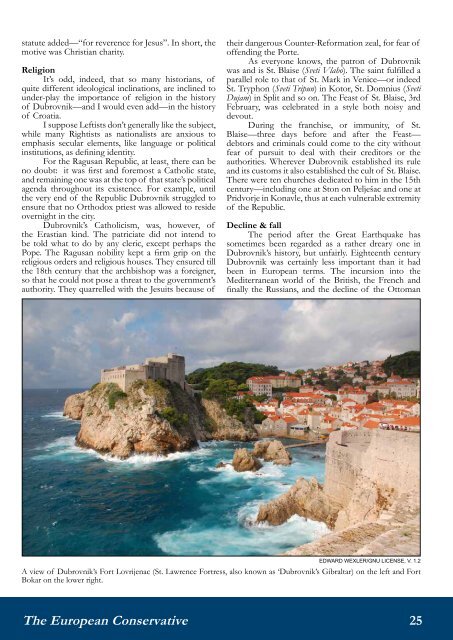CONSERVATIVE
eurocon_12_2015_summer-fall
eurocon_12_2015_summer-fall
- No tags were found...
Create successful ePaper yourself
Turn your PDF publications into a flip-book with our unique Google optimized e-Paper software.
statute added—“for reverence for Jesus”. In short, the<br />
motive was Christian charity.<br />
Religion<br />
It’s odd, indeed, that so many historians, of<br />
quite different ideological inclinations, are inclined to<br />
under-play the importance of religion in the history<br />
of Dubrovnik—and I would even add—in the history<br />
of Croatia.<br />
I suppose Leftists don’t generally like the subject,<br />
while many Rightists as nationalists are anxious to<br />
emphasis secular elements, like language or political<br />
institutions, as defining identity.<br />
For the Ragusan Republic, at least, there can be<br />
no doubt: it was first and foremost a Catholic state,<br />
and remaining one was at the top of that state’s political<br />
agenda throughout its existence. For example, until<br />
the very end of the Republic Dubrovnik struggled to<br />
ensure that no Orthodox priest was allowed to reside<br />
overnight in the city.<br />
Dubrovnik’s Catholicism, was, however, of<br />
the Erastian kind. The patriciate did not intend to<br />
be told what to do by any cleric, except perhaps the<br />
Pope. The Ragusan nobility kept a firm grip on the<br />
religious orders and religious houses. They ensured till<br />
the 18th century that the archbishop was a foreigner,<br />
so that he could not pose a threat to the government’s<br />
authority. They quarrelled with the Jesuits because of<br />
their dangerous Counter-Reformation zeal, for fear of<br />
offending the Porte.<br />
As everyone knows, the patron of Dubrovnik<br />
was and is St. Blaise (Sveti Vlaho). The saint fulfilled a<br />
parallel role to that of St. Mark in Venice—or indeed<br />
St. Tryphon (Sveti Tripun) in Kotor, St. Domnius (Sveti<br />
Dujam) in Split and so on. The Feast of St. Blaise, 3rd<br />
February, was celebrated in a style both noisy and<br />
devout.<br />
During the franchise, or immunity, of St.<br />
Blaise—three days before and after the Feast—<br />
debtors and criminals could come to the city without<br />
fear of pursuit to deal with their creditors or the<br />
authorities. Wherever Dubrovnik established its rule<br />
and its customs it also established the cult of St. Blaise.<br />
There were ten churches dedicated to him in the 15th<br />
century—including one at Ston on Pelješac and one at<br />
Pridvorje in Konavle, thus at each vulnerable extremity<br />
of the Republic.<br />
Decline & fall<br />
The period after the Great Earthquake has<br />
sometimes been regarded as a rather dreary one in<br />
Dubrovnik’s history, but unfairly. Eighteenth century<br />
Dubrovnik was certainly less important than it had<br />
been in European terms. The incursion into the<br />
Mediterranean world of the British, the French and<br />
finally the Russians, and the decline of the Ottoman<br />
EDWARD WEXLER/GNU LICENSE, V. 1.2<br />
A view of Dubrovnik’s Fort Lovrijenac (St. Lawrence Fortress, also known as ‘Dubrovnik’s Gibraltar) on the left and Fort<br />
Bokar on the lower right.<br />
The European Conservative 25


